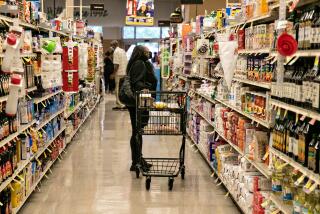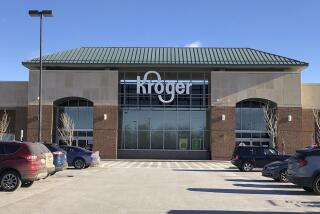Kellogg’s Crunch : Cereal Maker Is Doing Battle to Regain Market Share
- Share via
Kellogg Co. is still the nation’s biggest producer of ready-to-eat cereals and one of America’s most prosperous companies. But its dominance of the U.S. cereal market has eroded steadily in recent years, thanks largely to the growth of cheaper private-label brands.
So Kellogg--maker of such familiar cereals as Corn Flakes, Rice Krispies and Raisin Bran--is fighting back.
Instead of continuing to raise prices while maintaining sales through coupons and other costly promotions, Kellogg is holding prices firm, boosting advertising and slashing costs to turn higher profits without turning off American supermarket shoppers.
As part of its cost cutting, Kellogg said Tuesday that it plans to cut production at its Battle Creek, Mich., headquarters and its Memphis, Tenn., plant, eliminating 1,075 jobs. Three weeks earlier, Kellogg announced plans to shutter its only West Coast plant, in San Leandro, Calif., where 325 people work.
When rival General Mills Inc., maker of Cheerios and Wheaties, lifted prices by about 3% early this month, Kellogg held prices steady, as it has since February, 1994. That was another signal that Kellogg was taking the offensive against its competitors, which also include Philip Morris Cos.’ Post cereals and Quaker Oats Co., analysts said.
Kellogg initially viewed its slipping market share as “a little trend” that would die out, said analyst Stephen M. Long of brokerage Wheat First Butcher Singer in Richmond, Va. “It hasn’t.”
In fact, Kellogg is only the latest big U.S. corporation that’s been unable to rest on its past dominance and now must adjust to inroads made by aggressive, lower-priced competitors. The same thing happened to General Motors Corp., International Business Machines Corp. and Eastman Kodak Co.
Kellogg spokesman Richard E. Lovell confirmed that the company’s strategic shift is “a reflection of our share not being as large as it used to be” and of the overall sluggishness of the cereal market.
Indeed, the $8-billion U.S. cereal market is currently as flat as soggy Corn Flakes. In the year ended July 16, industrywide volume sales slipped 0.2% from the prior year to 2.6 billion pounds, while sales measured in dollars edged up only 1.5% to $8.1 billion, according to Information Resources Inc., a market research firm in Chicago.
Kellogg’s share of that market, in terms of pounds sold, has dropped to 35.3% from 41.4% in 1988. During the same period, the share of private-label cereals has more than doubled to nearly 10% from 4.3%.
The stale cereal market, and the success of private labels (including store brands that carry the name of the supermarket where they’re sold), in large part reflects the aversion of many consumers to the rising cost of name-brand cereals, analysts said.
The issue flared anew this spring when two Democrats in Congress asked the Justice Department to investigate the industry on antitrust grounds. Reps. Charles E. Schumer of New York and Sam Gejdenson of Connecticut asserted that cereal prices had soared 90% since 1983, or at twice the rate of food overall.
The Grocery Manufacturers of America, the cereal makers’ trade group, disputed the figures and said that when coupons are factored in, prices rose less than the rate of inflation between 1989 and 1993.
In any case, some analysts are comparing Kellogg’s problems to those that faced Philip Morris two years ago, when its branded-cigarette business was steadily losing share to generic brands. Philip Morris retaliated by slashing prices April 2, 1993, a day that rocked the financial markets and was dubbed “Marlboro Friday.”
Analysts don’t expect Kellogg to take such drastic action with, say, a “Frosted Flakes Friday,” but the company “has made it clear they are going to get that market share back, and one can assume they’re going to be as competitive as they can with pricing,” Long said.
Kellogg, founded in the late 1800s by an Adventist doctor named John Harvey Kellogg who invented a way to make flaked cereal, had steadily raised prices in the 1980s and maintained sales growth by relying heavily on promotions--such as buy-one-get-one coupons, or BOGOs.
But, “in the 1980s they overpriced, and that opened a big umbrella for their competitors to come in [with lower prices], particularly the private labels,” said Nomi Ghez, an analyst at Goldman, Sachs & Co. in New York.
“We came to realize in early 1994 that BOGOs could deliver market share in the short term, but they were not the way to build our business for the long term,” Lovell said. So the heavy promotions were dropped.
Kellogg’s struggle isn’t readily apparent in its financial results.
Thanks to growth overseas--it now sells cereal in 160 countries--the company last year earned an eye-popping 40 cents on each dollar of its stockholders’ investment. That was no accident; Kellogg’s return on equity has surpassed 25% in 10 of the past 11 years.
The company’s sales have risen 50 consecutive years, and Kellogg has raised its dividend 38 straight years. In the past 12 months, Kellogg’s stock has risen 20%, closing Tuesday at $67.25 a share, up 25 cents, in New York Stock Exchange trading.
But signs of trouble have been evident.
Kellogg’s profit and sales in 1994 rose only 4% from the prior year despite the foreign-market gains. Analyst John Bierbusse of A.G. Edwards & Sons Inc. in St. Louis has predicted that 1995 will be the third straight year that Kellogg’s earnings per share rise less than 10% (excluding one-time charges).
Another analyst, David Rabinowitz of Smith Barney Inc. in New York, is concerned that Kellogg won’t get much help from ending its heavy use of coupons and other giveaways.
In a report early this month, he wrote that Kellogg’s weakness reflects a “secular shift in the market” whereby consumers are increasingly buying lower-priced cereals and that the shift “will only worsen as promotional subsidies are reduced.”
(BEGIN TEXT OF INFOBOX / INFOGRAPHIC)
Losing Its Snap, Crackle and Pop?
Even as Kellogg’s dominance shrinks...
Kellogg Co. remains the nation’s largest cereal maker, but cheaper private-label brands have increasingly cut into its lead in recent years.
Kellogg
1995*: 35.3%
Private label
1995*: 9.9%
* As of July 16
U.S. Market Share
Kellogg: 35.5%
General Mills: 22.7%
General Foods (Post): 13.1%
Private Label: 9.9%
Quaker Oats: 8.2%
Others: 10.8%
...its financial results haven’t gone stale
Kellogg’s profitability remains strong, thanks largely to international sales.
Sales (in billions of dollars)
1994: $6.6
Profit (in millions of dollars)
1994: $705
Sources: Kellogg Co., Information Resources Inc., A.G. Edwards & Sons Inc.
More to Read
Inside the business of entertainment
The Wide Shot brings you news, analysis and insights on everything from streaming wars to production — and what it all means for the future.
You may occasionally receive promotional content from the Los Angeles Times.











